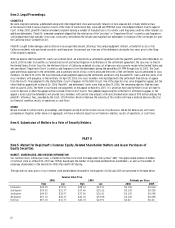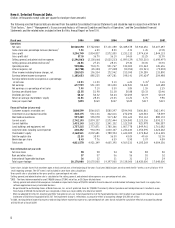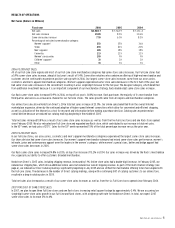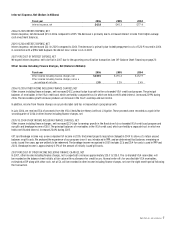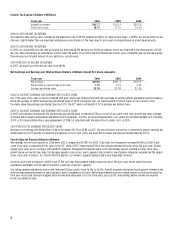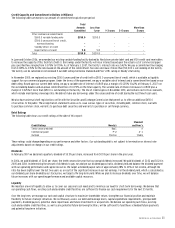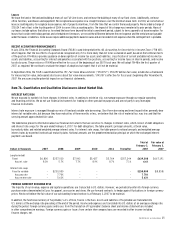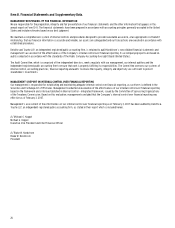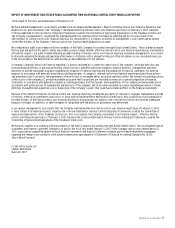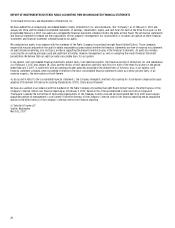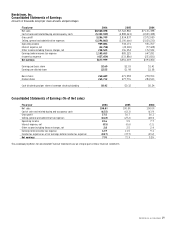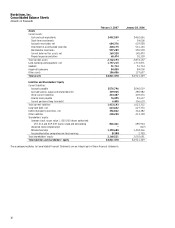Nordstrom 2006 Annual Report Download - page 38
Download and view the complete annual report
Please find page 38 of the 2006 Nordstrom annual report below. You can navigate through the pages in the report by either clicking on the pages listed below, or by using the keyword search tool below to find specific information within the annual report.20
LIQUIDITY AND CAPITAL RESOURCES (Dollars in Millions)
Overall, cash decreased by $60.1 to $402.6 as of February 3, 2007. Over the course of the year, we sold $350.0 of our interest in the co-branded VISA
receivables primarily to retire $300.0 of debt, and we repurchased $621.5 worth of stock. Our strong cash flow and low debt levels place us in a
position of flexibility to support our value growth plan.
Operating Activities (Dollars in Millions)
2006 VS 2005 OPERATING ACTIVITIES
Net cash flow from operating activities increased from $776.2 to $1,142.4, an increase of $366.2 primarily because we reduced our investment in asset
backed securities by $350.0 to fund the repayment of $300.0 of private label securitization debt. Also, we were successful in expanding our private label
charge card and co-branded Nordstrom VISA credit card programs, which increased our investment in these programs but provided increased earnings.
2005 VS 2004 OPERATING ACTIVITIES
Net cash flow from operating activities increased from $606.3 to $776.2, an increase of $169.9 primarily due to the growth in our net earnings. Our
co-branded VISA credit card program continued to grow in 2005 as we increased the capital we allocate to fund this program. Under our co-branded
VISA program, we earn interchange and finance charge income and we offer card holders merchandise certificates, which can be redeemed in our
stores, similar to a gift certificate.
In the course of negotiating for store locations, some developers offer up-front cash payments to defray our capital expenditures in exchange for our
commitment to operate a store in their development. In 2005, we received incentives totaling $49.5, which is an increase of $29.6 over 2004. Property
incentive receipts vary year to year, depending on the number of our store openings and remodels and the arrangements we negotiate with developers.
2007 FORECAST FOR OPERATING ACTIVITIES
In 2007, we will move the co-branded VISA receivables onto our balance sheet as part of the securitization transition (see Off-Balance Sheet
Financing on page 21). We expect operating cash flows to decrease due to this change and receivable growth. Increased net earnings are expected to
partially offset this decrease.
Investing Activities (Dollars in Millions)
In the past three years, we have had two principal types of investing activities: capital expenditures and short-term investments.
CAPITAL EXPENDITURES
Our annual capital expenditures ranged from $246.9 to $271.7 between 2004 and 2006. The largest components of these expenditures were for new
or relocated stores and store remodels.
In 2006 we opened one Full-Line store at The Gardens Mall in Palm Beach Gardens, Florida, we relocated our Topanga store in Canoga Park, California
and we opened one Rack store at Grand Plaza in San Marcos, California. Together these openings increased our gross square footage approximately
1.2%. Our total square footage as of February 3, 2007 was 20.2 million. In 2006, 35% of our capital expenditures were for new or relocated stores,
32% were for major remodels and 7% were for minor remodels. In addition, 13% of our capital expenditures were for information technology and
13% were for other projects.
Our capital expenditures over the last three years totaled $782.9. These capital expenditures were offset by property incentives of $100.0. With these
capital expenditures, we added stores, enhanced existing facilities and improved our information systems. More than 1.0 million square feet of retail
store space have been added during this period, representing an increase of 5.4% since January 31, 2004.
We expect that our capital expenditures will be approximately $2,800.0 over the next five years, with $520.0 to $540.0 planned for 2007. We plan to
use 52% of this investment to build new stores, 27% on remodels, 9% on information technology and 12% for minor remodels and other projects.
Compared to the previous five years, capital expenditures will increase 138%, with increased spending allocated to new stores. Our current strategy
calls for a 4% to 5% annual increase in square footage growth, with 26 new or relocated stores announced through 2011; over half of these stores will
be in our Northeast and Midwest regions. The estimated capital project spending does not include potential investments in new stores resulting from
the current industry consolidation. We believe we have the capacity to address additional capital investments should opportunities arise.
In the second half of 2007, we expect to open three new Full-Line stores and one Rack store, and in the first quarter of 2008, we expect to open four
new Full-Line stores. We typically incur the majority of our pre-opening costs in the six months prior to opening. In 2007, new store pre-opening costs,
which will be recorded in selling, general and administrative expenses, are expected to impact our earnings per diluted share by $0.03.
As of February 3, 2007, we were contractually committed to spend $32.2 for constructing new stores, remodeling existing stores, and other
capital projects.
SHORT-TERM INVESTMENTS
In 2006, we sold our short-term investments and primarily used the proceeds for common stock repurchases.


